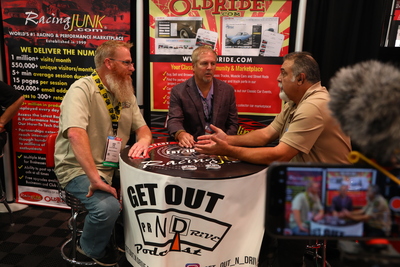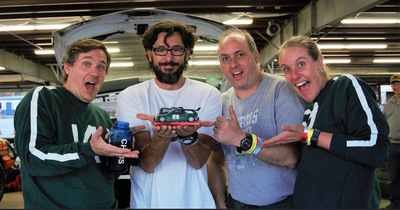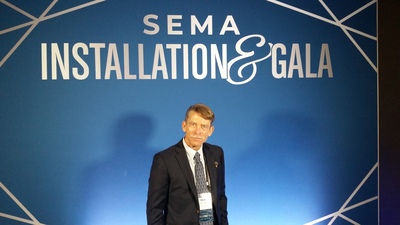BUSINESS
“A Message From You, the Sponsor”
Automotive Podcasts Are Undervalued Despite Astronomical Growth. Sponsor One While It’s Still Affordable.
By Chris Shelton

John “CustomCarNerd” Meyer (right), producer Joann Meyer (not shown), and Jason “OldeCarrGuy” Carr (left) joke that they deliver everything you never thought you’d want to know about cars on “Get Out N Drive.” As the title suggests, they encourage listeners to use their vehicles as intended, which drives traffic to their sponsor’s collector-car classifieds and content.
A pattern began to emerge while researching “Your Message Here,” our October 2022 SEMA News article explaining why and how industry professionals should contribute to automotive podcasts as guests: It felt impossible to talk about the marketing potential of appearing on a podcast without examining the virtues of sponsoring one.
What the experts we consulted urged had nothing to do with paying to appear as a guest. Rather, they described a frontier market where cost may not always reflect the true value of the medium, or at least what that medium may be worth one day. To summarize, the automotive segment of the podcast market is growing by leaps and bounds in titles and listeners alike. And so far, sponsors/advertisers seem slow to seize the opportunity.
It’s hard to blame them: Podcasts don’t really fit the marketing model that most people think of. In that model, quantity is king. Take the once-vast print market, where even a niche title could reach tens or even hundreds of thousands of people. When talking potential customers, more is better—right?
Giants like “Collecting Cars” and “The Smoking Tire” notwithstanding, podcasts typically don’t pull the audience numbers that we’ve come to expect from other formats. Yes, there are more listeners by the day; but there are also more podcasts vying for their ears.
What distinguishes podcasts is the quality of their audiences. “The fan base that you get is very dedicated and loyal, a base that specifically sought you out,” says “Get Out N Drive” producer Joann Meyer. “It’s not like they’re just flipping on the TV and we happen to be on. They’re looking for this type of content. So, we have a very loyal base that’s very specific in the niche that we’re in.”
And the niches can get narrow. “For example, we are involved with a number of podcasts and one of them focuses solely on road racing,” explains Mark Menadier, business-development manager for online marketplace RacingJunk.com.

Every week since 2017, “Everyone Racers” Christopher Abbott, Christian “Mental” Ward, Jeff Wakemen and Chrissy Mittura meet to dish about amateur endurance racing. By minimizing production cost and optimizing relationship value, they’ve established a modest-but-dedicated following that overlaps almost perfectly with RacingJunk.com’s marketplace.
Targeted Reach
“We may not have a large fan base, but you’re reaching every single one of those people that’s downloading our information,” says Christian “Mental” Ward, co-host of “Everyone Racers.” “Podcasts don’t play in the background. It’s not something that’s, you know, on the radio. It’s nothing like that. It is very targeted. So, it is super engaging.”
“You’re getting engaged with people in a way that you don’t ordinarily,” Meyer adds. “This is the kind of stuff you hear when you’re talking to somebody at a car show.” With that comes a kind of trust that’s rare in the marketing world. “I think from a consumer standpoint, it’s you know, ‘I’m going to find someone who thinks like me and acts like me, and they’re going to give me an honest review of this particular product,’” Ward says.
They’re far from wrong. Earlier this year, iHeart Media released the results of a study that indicates that “consumers perceive radio and podcast personalities as highly relatable, trustworthy and authentic.” According to “Exploring the Brand Benefits of Trust and Companionship in Audio,” “These findings present rich opportunity for advertisers to build brand affinity and favorability, and drive purchase in audio environments.”
And it’s a good audience to have: According to the Westwood One 2021 Audioscape, 53% of podcast listeners have white-collar occupations, 39% have management positions, 55% have a household income of $75,000 or higher, and 39% have incomes of $100,000 or more. Take “Everyone Racers,” Menadier says. “That audience tends to be more affluent. The participants are generally self-sponsored. There’s not a whole lot of spectators in road racing, so there’s not a lot of sponsorship opportunity. So, the road racers themselves tend to be great customers because they have the means.”
Obviously, fit is crucial to a good relationship. And like most crucial things, that isn’t always straightforward. In fact, the best option for some would-be sponsors is retaining a conventional marketing firm that knows your industry and buyer’s demographics.
Regardless of the choice, it pays to understand some of the mechanics behind the decisions essential to finding a good match. “Let’s go back to one extremely crucial element,” Menadier says. “Does their audience line up with your target customer base? That’s the first thing, right?
“Let’s say that I sell dirt-car parts,” he continues. “I want to get involved in a podcast that only talks about dirt, and there are podcasts that are that esoteric. Having the ability to hyper-target your audience—especially if you’re a company that focuses on a specific automotive niche—is a great thing about podcasts.”
But according to Ward, perfect alignment isn’t always the best option. “You don’t necessarily want to go to the direct market,” he says. “If it’s exactly your demographic, then there’s a 90% chance the listeners already know about your product.” Solution? Adjacent marketing. “You can start finding the mutually beneficial cross promotion adjacent to your audience. In our case, we’re endurance road racers [and] there’s a lot of crossover to the vintage road-racing crowd.”
Menadier urges would-be sponsors to study their prospective outlets. “Do they come across as professional? Do they have good content? Do they bring in quality guests? How often do they publish? Do they do remote, on-site recordings? Do they go to industry events? Are the engagement stats, audience base, reviews, comments and interaction skills good? Those factors play into the decision-making process.” He also recommends contacting the podcast’s current and past sponsors to get a take on their experience.
At the same time, he underscores the value of underdogs. “If I see a podcast that’s got potential, and after talking with them and looking at how they present themselves, I’ll pay attention. If I see potential for growth within a year or two, then I’ll jump on board with them and do everything I can to help them gain downloads. If you see potential in a yet-to-be-known podcast and you can get your foot in the door, your value as a sponsor is going to be higher down the road.
“So just to round out the thought, what I saw in ‘Get Out N Drive’ were the things that I look for in a successful podcast, and they were just barely getting off their feet,” Menadier continues. Host John Meyer was at the tail end of a decades-long career turning wrenches and Joann runs a successful catering business. “They had the background [and] she had the organizational and administrative wherewithal. So you know, they’re a good example.”
As counterintuitive as it sounds, there’s also such a thing as a market that’s too big. “Good example is the very first podcast that we got involved with,” he recalls. “He’s an off-road racer, super well-known in the off-road world. We got on with him and he already had a substantial following, but it got to the point that we just got swallowed up. We were, in that podcast’s eyes, a little fish in a very large ocean.”

The common denominator to these podcast titles and RacingJunk.com is Mark
Menadier. As business development manager for Internet Brands, parent company of a dozen automotive-themed online entities, he handles the company’s partnerships and special projects. He’s a driving force behind the company’s push into niche markets by way of engaging grassroots podcasts.
Message Placement
How producers work sponsor messages into episodes varies across the industry, but most fall into a few very familiar formats. Our October 2022 SEMA News “Your Message Here” article likened podcasts to old-time radio shows. The familiar “message from our sponsor” delivered by a program host or cast falls under the broad heading of host-read ads.
But these aren’t necessarily the formal spots of yore. “We ask [producers] for our messaging to contain an idea, but we don’t script it,” Menadier says. “We ask them to work it in organically, however they can. And most of them do it. That’s something that ‘Everyone Racers’ does well.” For example, “Everyone Racers” works
Racingjunk.com into a piece called “What I Found on RacingJunk.com.”
“When we started this relationship, they really kind of didn’t place any expectations on this,” Ward explains. “All of us go on RacingJunk.com anyway. We find something interesting and just talk about it.” What exists to promote a sponsor turns into an entertainment segment. “That gives us more than the typical 30- or 60-sec. spot,” Menadier says. Furthermore, listeners are more likely to hear a message from a sponsor if it includes novel and entertaining information.
Whether host-delivered or sponsor-generated, sponsorship messaging appears in one of three places in a podcast: pre-roll, or before the episode starts; mid-roll, or anywhere during the episode; and post-roll, or after the episode ends. And not all messages are baked into the program. Many producers essentially leave blanks in the programming that they fill at will. Dynamic ads, as they’re known, are a great way to sponsor evergreen episodes that see frequent downloads long after their initial publishing date.
Because podcasts rely on the internet for dissemination, they leave a digital paper trail. Producers then mine that trail for valuable information about listener habits that they can use to court sponsors and determine the podcast’s marketing value.
The basic marketing metrics include cost per click (CPC), cost per mille (CPM), cost per lead (CPL) and cost per action (CPA). CPC explains itself: the producer charges a set amount per click, in this case per-episode download. CPM amounts to the same thing, but in blocks of a thousand clicks.
CPL represents the amount a sponsor pays whenever a consumer follows a lead to a sponsor’s business; CPA represents the amount a sponsor pays whenever a consumer purchases a product.
CPL and CPA make up the backbone of affiliate marketing. Though affiliate marketing comes in many forms, you’re probably most familiar with it in review websites. The “See price at XYZ” buttons that usually accompany a product or service send users to a unique page on the sponsor’s site. If the arrangement pays based on CPL, the producer earns commission on every click that lands a user at the sponsor’s unique page. And in the CPA model, the sponsor pays every time a user buys the advertised product.
Naturally the audio-only format precludes counting clicks beyond the one used to download the podcast episode. But operators in the podcast sphere have developed a workaround, creating unique coupon codes that let the sponsor know where the users heard about the sponsor’s products or services.
Asking how much it costs to sponsor a podcast is akin to asking how much it costs to buy a car or a house. The variables are so diverse that it’s impossible to put a blanket figure on it. Thankfully those are questions that a well-maintained media kit can answer.
But even in some of the most successful arrangements, podcast sponsorship can often cost very little—and in some cases literally nothing, depending on the sponsor’s presence in the industry. “This movement is in such an emerging stage that people are basically bartering for exposure on each other’s platforms,” Ward reveals. In their relationship, ‘Get Out N Drive’ and ‘Everyone Racers’ lead traffic to RacingJunk.com. “With RacingJunk.com, they feature us in their newsletter quite often, which is good for us because it opens us up to a bigger market,” he continues.
“The more we promote them, the more they’re promoted, and the more we get promoted,” Menadier says. It’s a synergistic circle, there’s no question about it. It’s almost like you can’t wash your right hand without your left hand. Our arrangement with them is a perfect example of that.”
“RacingJunk.com has been a huge help to us,” Joann Meyer says. “I met Mark on LinkedIn, and we have gone from there. They have provided us with a wealth of guests and potential sponsors. We’re not in the getting-paid-to-sponsor gig, but we’ll be there someday.”
Menadier says adding a podcast to the mix is the next logical step for a few reasons. “The first one being you’re potentially tapping into an audience that has not heard your message and has maybe not heard of you as a company, your business.”
“The second, and almost as important reason, is because you’re reinforcing whatever other messaging you have going on in your mix,” he continues. “What if that person listening to the podcast happens to be someone that follows you on social? Hearing your name mentioned on a podcast just reinforces what you’re already doing.”
For now, podcast sponsorship represents one of the more affordable means to deliver a company’s message to a very specific audience. But not for long, Mark Menadier predicts. “Podcasts really have taken off not only in popularity with the listeners, but popularity with people who are finding another way to make a dollar,” he says. It’s only a matter of time until more businesses discover the potential to access target markets, at which point the value will reflect the medium’s power. “It’s best to get in early,” Menadier observes, “because then you get favorable treatment down the road.”






